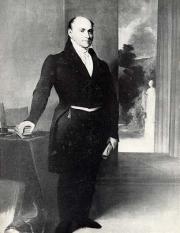Accepting Smithson's Gift
Smithson's Bequest Sparks Political Debates
 Whether or not to accept the Smithson bequest was a matter of controversy among the ranks of those governing the new nation. States' rights advocates, nationalists, federalists, anglophobes, xenophobes, and others disagreed over the possible repercussions of accepting such a gift.
Whether or not to accept the Smithson bequest was a matter of controversy among the ranks of those governing the new nation. States' rights advocates, nationalists, federalists, anglophobes, xenophobes, and others disagreed over the possible repercussions of accepting such a gift.
President Andrew Jackson asserted his belief that the people of the United States would ultimately put such opportunities to good use. Unsure whether the Constitution gave him the authority to accept the Smithson bequest, he asked Congress to pass legislation allowing him to do so.
Congress authorized acceptance of the Smithson bequest on July 1, 1836. President Jackson took immediate steps to secure the bequest by sending diplomat Richard Rush to England.
"Beneath [Our] Dignity"
 "We accept a fund from a foreigner, and would … enlarge our grant of power derived from the States of this Union … Can you show me a word that goes to invest us with such a power?"-Senator John C. Calhoun (South Carolina), February 25, 1836
"We accept a fund from a foreigner, and would … enlarge our grant of power derived from the States of this Union … Can you show me a word that goes to invest us with such a power?"-Senator John C. Calhoun (South Carolina), February 25, 1836
Senator John C. Calhoun opposed acceptance of the Smithson bequest, largely on the grounds that to do so on behalf of the entire nation would abridge states' rights. He maintained that Congress had no authority to accept the gift. He also asserted that it would be "beneath [U.S.] dignity to accept presents from anyone."
"[E]very whippersnapper vagabond … might think it proper to have his name distinguished in the same way."-Senator William Campbell Preston (South Carolina) April 30, 1836
Senator William Campbell Preston for several years was part of a small but vocal minority who questioned the constitutionality of accepting Smithson's bequest. Ultimately, persuaded by advocates for a national university, he devoted himself to developing the newly established Smithsonian Institution.
 Opponets of the bequest made their case in the popular press as well as in the halls of Congress.
Opponets of the bequest made their case in the popular press as well as in the halls of Congress.
"The Bequest...Faithfully Carried into Effect"
As the chairman of the Congressional select committee to determine what to do about the bequest, Congressman John Quincy Adams (formally U.S. President) maintained that the endowment could have far-reaching consequence for the young county. He advocated applying the money toward scientific research.
"If then, the Smithsonian Institution, under the smile of an approving Providence, and by the faithful and permanent application of the means furnished by its founder...should contribute essentially to the increase and diffusion of knowledge among men, to what higher or nobler object could this generous and splendid donation have devoted?" –Representative John Quincy Adams (Massachusetts) January 19, 1839
Interest in the Smithson bequest was so strong that newspapers printed the full text of House Report 181 urging that the bequest be “faithfully carried into effect.”
Pursuring the Smithson Bequest

The Court awarded Smithson's properties, valued at the equivalent of $508,318, to the United States on May 9, 1838.
Rush personally posted a $500,000 bond as insurance that he would not abscond with the Smithson bequest.
"A suit of higher interest and dignity has rarely, perhaps, been before the tribunals of a nation. . . . Benefits may flow to the United States and the human family not easy to be estimated." -Richard Rush (1780-1859)
 "[Being in the Court of Chancery is like] being ground to bits in a slow mill; it's being roasted at a slow fire; it's being stung to death by single bees; it's being drowned by drops; it's going mad by grains."-Tom Jarndyce in Charles Dickens, Bleak House, 1853
"[Being in the Court of Chancery is like] being ground to bits in a slow mill; it's being roasted at a slow fire; it's being stung to death by single bees; it's being drowned by drops; it's going mad by grains."-Tom Jarndyce in Charles Dickens, Bleak House, 1853
In his letters to U.S. Secretary of State John Forsyth, Rush complained that the British Court of Chancery was overly complex and bureaucratic, with excessive fees and clerks to be paid at every step. Exasperation with the Court--which was more than 800 cases in arrears--was a theme of several popular novels of the period, including Dickens' Bleak House.
International finance was a cumbersome process in the days before air mail and electronic transfers. Rush spent two years in London securing the Smithson bequest. His expenses, which amounted to about $10,000, were handled by the Rothschild bank, which acted as the European bank to the United States.
After winning his case on behalf of the United States, Rush sold the properties that made up the Smithson bequest and converted the proceeds into gold sovereigns.

"Somewhat worn down by fatigue since coming on shore, after an uncomfortable voyage of squalls, gales, and headwinds, I venture to ask a little repose at my home before proceeding to Washington." -Letter from Richard Rush to Secretary of State John Forsyth, September 4, 1838
Several inventories were made of James Smithson's belongings, including his clothing and jewelry, household items, books, and mineral specimens. Rush brought many of these items to the United States with the gold.
Upon his arrival in New York, Rush transferred the gold to the U.S. Treasury. The coins were melted down to yield a value of $508,318.46.







![Inventory of James Smithson's Belongings, 1829, [1841-42], Smithsonian Institute Archives Black and white handwritten document.](https://siarchives.si.edu/sites/default/files/attached-images/inventory_smithson.jpg)